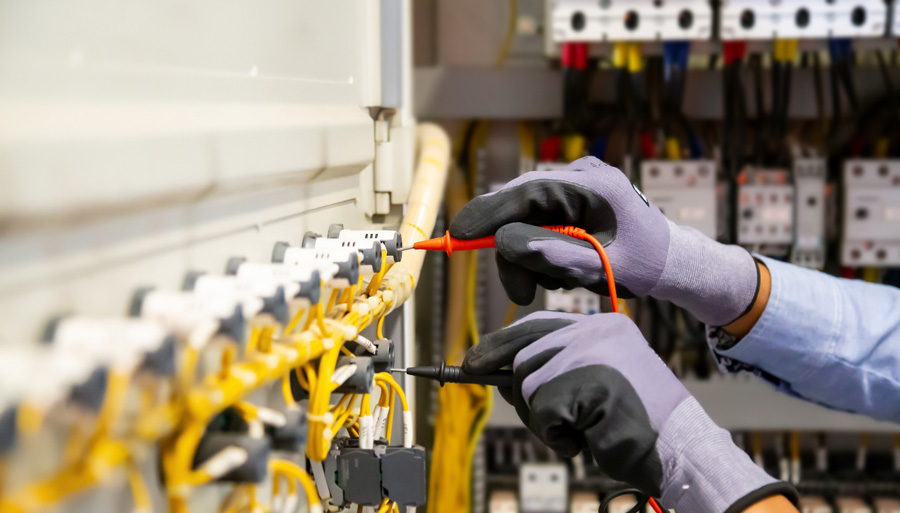
Electrical fires: what causes them and how can we fight them?
Today, some of the most common causes of fires in industrial buildings are failures in the electrical installations necessary for the proper functioning of the building and its machinery.
These electrical fires spread extremely fast and are very dangerous, posing a high risk to buildings, property and people. Faced with this threat, it is important to know all the details of this type of fire in order to combat and avoid them.
What are the main causes of electrical fires?
The list of causes that lead to this type of fire is extensive, but some of the most common are:
⇢ Misuse of cables or damage thereto
In many buildings, cables are poorly organized and stored (often being positioned one on top of the other and, in some cases, trapped under heavy machinery or stored items). This can cause overheating of the current and start a fire that will spread to the space and the stored goods.
But not only that: there are also electrical installations with damaged, worn and broken cables or cables without adequate insulation, risks that can cause short circuits (and also generate sparks and flames).
⇢ Faulty connections
It is also important to note that a faulty connection often creates problems. An example? A bad connection can generate an increase in resistance, causing some elements, such as switches, to heat up (causing problems due to high temperatures and overheating).
⇢ Lack of hygiene
Dirt is also a serious problem that can cause accidents in many electrical installations. Dust in contact with moisture, for example, can cause short circuits and generate dangerous flames for any building.
But not only this. Beyond the causes mentioned above, there are many other threats that we must take into account, such as the following:
- Initial design errors in the electrical installation;
- Failures in the choice of protections;
- Improper connection of the electrical system with the machinery;
- Hiring a lower voltage than necessary;
- Breach of regulations.
Faced with all these risks, a fundamental question is…
How can we prevent these electrical fires?
To promote the safety of any building, it is essential to design the electrical installation correctly and invest time and resources in constant maintenance (checking from time to time that all the elements are in good condition, are well organized and there is nothing that affects to its correct operation). This will undoubtedly help to keep the facilities in perfect condition and drastically reduce threats.
Even so, it is essential to also have a fire protection plan that helps us fight the flames; a plan that must have several elements such as the following:
⇢ Temperature control systems
Due to the rapidity of electrical fires and the damage they can cause, it is recommended to avoid the risk as much as possible and to be as far-sighted as possible. How? By having temperature control and monitoring systems.
The goal of these systems is to detect hot spots in any part of the electrical installation and act before a spark or flame appears. To achieve this, thermal cameras or even infrared thermography techniques can be used.
⇢ Fire detectors
Within any electrical fire protection plan, it is essential to have automatic detection systems that sound the alarm in the event of any anomaly, warning personnel of the danger.
Today, there are different types of detectors, but for this type of fire, we recommend highly sensitive smoke or gas detectors that can issue a warning when the first signs of fire appear.
⇢ Extinguishing systems
Our fire plan should not only target detection. It is also essential to have extinguishing systems able to control and extinguish this type of fire to reduce its impact and damage.
But which one to use for electrical fires? In this type of fire, it is best to avoid solutions that use water as an extinguishing liquid (since water, which is electrically conductive, can lead to electrocution).
On the contrary, we recommend using gas extinguishing systems. Gaseous agents are not conductors of electricity (thus avoiding sparks or other flame retardant phenomena) and they cause less damage in the place where they act (they are clean solutions that do not generate waste, so they do not damage the tools and resources of an electrical installation).
⇢ Sectioning against fires
In addition to detection and extinction, it is also essential to have fire curtains and smoke control barriers to help contain the fire in the area where the flames have started and prevent their spread. This will protect the rest of the building, reduce damage to stored goods and help workers while evacuating.
With all this in mind, are you thinking about how to improve the safety of your installation against electrical fires? Regardless of the solution that most appeals to you from those mentioned here, it is important that you take into account that each warehouse or building is unique and needs a personalized fire protection plan adapted to its needs. For this reason, we recommend that you carry out a preliminary study to find out the characteristics of your project and what risks it faces in order to create a complete security plan adapted to your specific case.